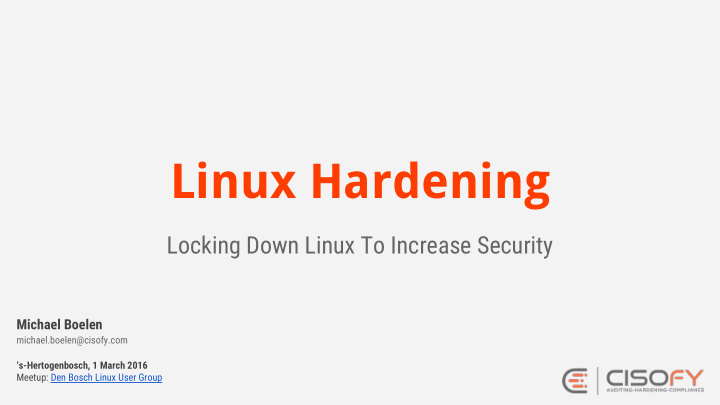



Linux Hardening Locking Down Linux To Increase Security Michael Boelen michael.boelen@cisofy.com ‘s-Hertogenbosch, 1 March 2016 Meetup: Den Bosch Linux User Group
Goals 1. Learn what to protect 2. Know some strategies 3. Learn tooling Focus : Linux 2
Agenda Today 1. System Hardening 2. Security Auditing 3. Guides and Tools Bonus: Lynis demo 3
Michael Boelen ● Open Source Security ○ rkhunter (malware scan) ○ Lynis (security audit) ● 150+ blog posts at Linux-Audit.com ● Founder of CISOfy 4
System Hardening
Q: What is Hardening?
7
Q: Why Hardening?
Q: What if we don’t?
11
12
13
14
15
16
Hardening Basics
Hardening ● New defenses ● Existing defenses ● Reduce weaknesses Photo Credits: http://commons.wikimedia.org/wiki/User:Wilson44691 (attack surface) 18
Myth After hardening I’m done 19
Fact ● Security is an ongoing process ● It is never finished ● New attacks = more hardening ○ POODLE ○ Hearthbleed 20
Hardening What to harden? ● Operating System ● Software + Configuration ● Access controls 21
Hardening Operating System ● Packages ● Services ● Configuration 22
Hardening Software ● Minimal installation ● Configuration ● Permissions 23
Hardening Access Controls ● Who can access what ● Password policies ● Accountability 24
Hardening Encryption ● Good : Encryption solves a lot ● Bad : Knowledge required ● Ugly : Easy to forget, or do it incorrectly 25
Technical Auditing
Auditing Why audit? ● Checking defenses ● Assurance ● Quality Control 27
Common Strategy 1. Audit 2. Get a lot of findings 3. Start hardening 4. ……. 5. Quit 28
Improved Strategy 1. Focus 2. Audit 3. Focus 4. Harden 5. Repeat! 29
Hardening Resources
Options ● Guides ● Tools (SCAP / Lynis) ● Other resources 31
Hardening Guides ● Center for Internet Security (CIS) ● NIST / NSA ● OWASP ● Vendors 32
Hardening Guides Pros Cons Free to use Time intensive Detailed Usually no tooling You are in control Limited distributions Delayed releases Missing follow-up 33
Tooling
Tools Tools make life easier, right? Not always... 35
Tools Problem: There aren’t many good tools 36
Tools Cause 1: Usually outdated 37
Tools Cause 2: Limited in their support 38
Tools Cause 3: Hard to use 39
Tool 1: SCAP
SCAP ● S ecurity ● C ontent ● A utomation ● P rotocol 41
SCAP Combination of: ● Markup ● Rules ● Tooling ● Scripts 42
SCAP features ● Common Vulnerabilities and Exposures (CVE) ● Common Configuration Enumeration (CCE) ● Common Platform Enumeration (CPE) ● Common Vulnerability Scoring System (CVSS) ● Extensible Configuration Checklist Description Format (XCCDF) ● Open Vulnerability and Assessment Language (OVAL) Starting with SCAP version 1.1 ● Open Checklist Interactive Language (OCIL) Version 2.0 Starting with SCAP version 1.2 ● Asset Identification ● Asset Reporting Format (ARF) ● Common Configuration Scoring System (CCSS) ● Trust Model for Security Automation Data (TMSAD) 43
Complexity? List of Tables (Common Configuration Scoring System (CCSS)) Table 1. Access Vector Scoring Evaluation ..................................................................................8 Table 2. Authentication Scoring Evaluation ..................................................................................9 Table 3. Access Complexity Scoring Evaluation.........................................................................10 Table 4. Confidentiality Impact Scoring Evaluation.....................................................................11 Table 5. Integrity Impact Scoring Evaluation ..............................................................................12 Table 6. Availability Impact Scoring Evaluation ..........................................................................12 Table 7. General Exploit Level Scoring Evaluation.....................................................................13 Table 8. General Remediation Level Scoring Evaluation ...........................................................14 Table 9. Local Vulnerability Prevalence Scoring Evaluation.......................................................15 Table 10. Perceived Target Value Scoring Evaluation ...............................................................15 Table 11. Local Remediation Level Scoring Evaluation..............................................................16 Table 12. Collateral Damage Potential Scoring Evaluation ........................................................17 44
SCAP Overview Pros Cons Free to use Limited distributions Focused on automation Complexity Hard to customize 45
Tool 2: Lynis
Lynis 47
Lynis Goals ● In-depth security scan ● Quick and easy to use ● Define next hardening steps 48
Lynis Background ● Since 2007 ● Goals ○ Flexible ○ Portable 49
Lynis Open Source Software ● GPLv3 ● Shell ● Community 50
Lynis Simple ● No installation needed ● Run with just one parameter ● No configuration needed 51
Lynis Flexibility ● No dependencies* ● Can be easily extended ● Custom tests * Besides common tools like awk, grep, ps 52
Lynis Portability ● Run on all Unix platforms ● Detect and use “on the go” ● Usable after OS version upgrade 53
How it works 1. Initialise 2. OS detection 3. Detect binaries 4. Run helpers/plugins/tests 5. Show report 54
Running 1. lynis 2. lynis audit system 3. lynis audit system --quick 4. lynis audit system --quick --quiet 55
Demo?
Conclusions 1. Know your crown jewels (properly) 2. Determine hardening level 3. Perform regular checks 57
Success! You finished this presentation
Learn more? Follow ● Blog Linux Audit (linux-audit.com) ● Twitter @mboelen This presentation can be found on michaelboelen.com 59
Recommend
More recommend